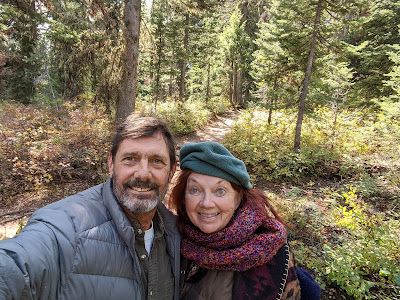 |
| On a blustery but sunny day at Hawaii's Kilauea Volcano, Bruce Keller and Christene "Cookie" Meyers take a selfie against the eerie but beautiful landscape of Hawaii Volcanoes National Park. |
 |
| Volcanoes formed the landscape and are still active. |
PELE'S POWERS, TECTONIC SHIFTS BRING KILAUEA, MAUNALOA TO MODERN DAY TOURISTS
 |
| The Kilauea Volcano in all its glory. photo courtesy Hawaii Volcanoes National Park |
PHOTOS By BRUCE KELLER
HAWAII'S ACTIVE volcanoes are constantly causing a stir on The Big Island, where locals are ready for steam, smoke and fire at any time.
Volcano and earthquake hazards occur regularly, so that is always on the mind of the people.
Tourists -- including the two of us travel writers and photographers -- make it a point to have a look at these wonders of nature whenever we're in the area. The island's jet-black lava fields, white sand and snowy mountains make a photographer's dream, with hiking trails across a lunar-like landscape, and viewpoints to show it all off.
 |
| Pele, goddess of volcanoes and fire, is the star of a spectacular sound and light show at Smith Family Garden Luau. |
SINCE KILAUEA and Maunaloa volcanoes are both found here, there are national parks to give visitors the updated story and a chance to survey the ever changing landscape.
Hawaii Volcanoes National Park is about an hour from Hilo on the east side of the island, or two and one-half hours from Hilton Waikoloa Village on the western side of the island.
| Looking much like forest fire damage, its possible you might see the volcano burn. |
Other volcanoes on Hawaii Island include: Maunakea, Hualalai, and Kohala.
 |
| Informative guides give lively, scientific information on the volcanic action at Hawaii Volcanoes National Park. |
IT IS NEVER possible to predict the exact date and time of an eruption. Our naturalist guide told us, "Because these are active volcanoes, we can't say when they might blow again." Geophysical measurements indicate that Maunaloa's magma storage system has been recharging since the 1984 eruption. Since 2019, there have been signs of elevated unrest, but the next Maunaloa eruption doesn't appear imminent, our guide added.Hawaii has many remarkable features, including that Maunaloa is the largest active volcano on Earth. She covers an impressive half of the island, rising to 4,170 meters (13,681 feet) above sea level. Her long submarine flanks descend 5 km (3 miles) below sea level to the ocean floor.
MAUNALOA, like Kiluea, has a summit caldera and two active rift zones extending from its summit. Eruptions vary from short- to long-lived, and occur at the summit, or radial vents on her north and western flanks. Mauna Loa eruptions can begin with little warning, producing intense lava flows traveling long distances in short periods of time. Villages on the flanks of the volcano are naturally impacted.
 |
| These tourists admire the landscape of steam and smoke at Hawaii Volcanoes National Park on the Big Island. |
Hawaii is at the southeast end of a chain of volcanoes that began forming more than 70 million years ago. Each island is made of one or more volcano which erupted on the floor of the Pacific Ocean, emerging above sea level only after countless eruptions. Six volcanoes collaborated over a million ears to create The Big Island.
 |
| Bruce Keller and Christene "Cookie" Meyers enjoy a sunny autumn day in Yellowstone National Park. |

Fire and fun -- love the spin on history and volcanic lore
ReplyDeleteWow! I would love to see these volcanoes..... from a safe distance. So cool, and great to make use of our wonderful national park passes.
ReplyDelete